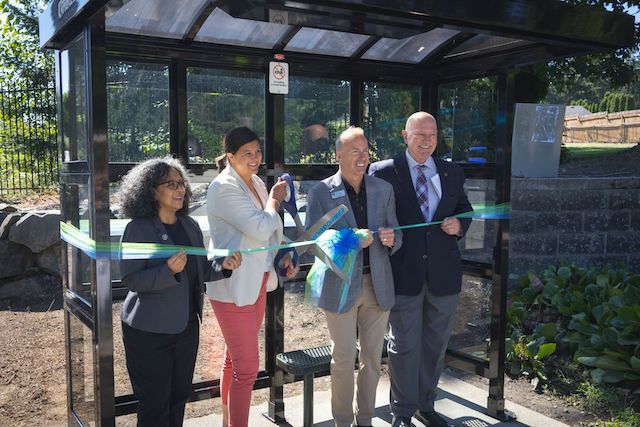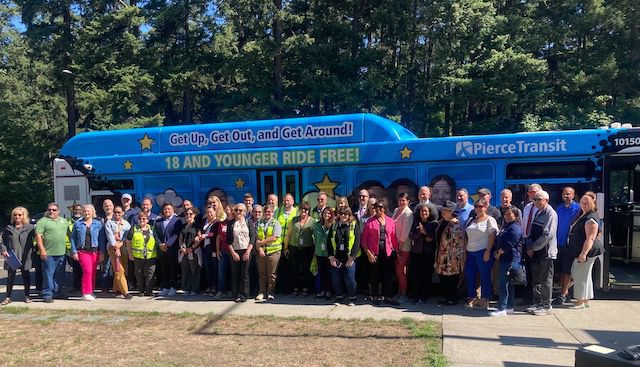Tacoma Weekly: Pierce Transit announces bus shelter upgrades, new projects

Across Pierce County, Pierce Transit makes more than 2,000 stops throughout its 292 square mile service area and more than 500 of these stops are at bus shelters. With a notable portion of these shelters situated in areas without much foot traffic or activity happening around them, it is important that they are kept as safe waiting places and well maintained for riders’ comfort and sense of security.
On Aug. 28, elected officials, dignitaries, Pierce Transit employees and riders gathered at one of Pierce Transit’s new shelters on Bridgeport Way West in Lakewood to celebrate the kickoff of a systemwide bus stop shelter upgrade project. Many are more than 20 years old and are showing signs of wear and tear, their larger glass panes are expensive to repair or replace, and most shelters lack any type of lighting.
The shelter renewal project replaces current shelters with new, redesigned shelters that specifically protect against vandalism. This includes equipping the new bus shelters with stronger and less breakable glass panels. The new shelters feature smaller panes of glass which make repairs more affordable and are easier and faster to install. The shelters also include a bench seat and solar lighting to improve the customer experience, as well as making it easier for bus drivers to see those waiting at the bus stop after dark. The new shelters are updated with a sleek black design and are sized to use the former shelter’s concrete pad, making for a simpler installation process.
The new shelters are being distributed across the Pierce Transit service area, prioritizing installations in locations with low and very low equity designations. By the end of this year, 93 upgraded bus shelters will be installed around Pierce County. Pierce Transit has a goal of replacing about one-fifth of its bus stop shelters each year with the upgraded design, provided funding is available.
The upgrades to bus shelters throughout Pierce Transit’s service area are made possible in part through a Community Project Funding/Congressionally Directed Spending grant award of $2.5 million in federal dollars supported by both Congresswoman Marilyn Strickland and Senator Patty Murray. The Puget Sound Regional Council’s Federal Highway Administration Equity Pilot Program grant award of $945,820 and some Pierce Transit local funds will also support the project.
At the ribbon cutting ceremony, Pierce Transit CEO Mike Griffus welcomed Strickland; Lakewood Mayor and Pierce Transit Commission Vice Chair Jason Whalen; Tacoma City Council member and Pierce Transit Board Chair Kristina Walker; Pierce County Council member and Pierce Transit Commissioner Marty Campbell; Pierce County Council member Jani Hitchen; Puyallup City Council member Lauren Adler; Lakewood Deputy Mayor Mary Moss; Lakewood City Council member Mike Brandstetter; University Place Mayor Pro Tem Ed Wood; Tacoma Deputy Mayor and Pierce Transit Board Member John Hines; University Place Assistant City Manager Eric Falson; Juan Beltran-Gonzales from Sen. Patty Murray’s office; and several representatives from the Lakewood Chamber of Commerce including its president and CEO Linda Smith.
Pierce Transit employees were also among the guests of honor and were thanked for their service to the transit system.
“I would like to give a real shout-out to the Pierce Transit employees who have been working on this project for the last couple of years,” Griffus said, and Whalen echoed these remarks.
“Much of the work Pierce Transit does for our riders and this community takes place behind the scenes,” Whalen said. “Every day, Pierce Transit employees clean bus stops, maintain vehicles and manage ride share groups. They arrange paratransit rides, they balance the agency’s budget, and they set up and maintain our significant technology systems to make all this work.
“While most of us are sleeping at night, Pierce Transit employees are wide awake washing, fueling and cleaning all of these incredible busses, making sure they’re ready to roll that next morning.”
Whalen pointed out that in contrast to this behind-the-scenes work, the milestone being celebrated at the ribbon cutting is very much in the public eye. He said that for a transit system, bus stops are one of the things people see most often, second only to seeing a bus roll by.

“A bus stop is even more visible when there’s a shelter sitting next to it or adjacent to it. As we all know, if the shelter is attractive and well cared for, one is more inclined to engage in transit or enjoy transit. If it’s downtrodden and looks in disrepair and not safe, you’re likely not going to engage in transit as you might otherwise do it. In the case of these new shelters, if it has great lighting powered by solar power, the more the better,” he said.
He spoke of how a well-lit and attractive bus shelter impacts the public’s perception of transit and the surrounding area.
“It also enhances that perception of transit for those of us considering riding as well as for those who already do,” Whalen said. “We know from community engagement surveys that it really is the perception of safety and reliability that triggers whether or not one is going to try transit for the first time or be a consistent rider.”
Before closing his remarks, Whalen said that over the next several years, Pierce Transit will be rolling out additional improvements that will enhance the customer experience. One of these will be to increase the frequency of service on many of Pierce Transit’s highest ridership routes as staffing and funding allows. Another is that Pierce Transit is preparing to launch an updated website that will be easier to navigate and will provide more information to aid riders in planning trips.
More forthcoming initiatives include a pilot project to install new tactile wayfinding aids for the visually impaired and providing real time arrival information at some bus stops and not just at the transit centers to enhance the customer service experience. In addition, Pierce Transit is preparing to launch a program pairing a Pierce Transit public safety officer with a mental health specialist as a rapid response team to help people in crisis within the Pierce Transit system.
Walker highlighted Pierce Transit’s six-year strategic plan with its first goal to adopt a customer first mindset “to ensure that Pierce Transit riders’ needs, comfort, safety and satisfaction are part of everything we do,” she said.
“Our plan is to replace about one-fifth of the shelters every year with this new upgraded design so they will be fully installed within five years. Importantly, we are starting these installations in areas with low or very low equity designations and making sure that those who are most dependent on public transportation and likely ride more often receive the new shelters first.”
Strickland noted that amid all these improvements and programs, Pierce Transit does not use the full authority of its taxing options.
“Every transit agency in the state can have up to nine-tenths of 1 percent of sales tax. Pierce Transit operates at six-tenths, so they don’t even use their full taxing authority and they’re still innovative, still doing new things, and that is a testament to their creativity and dedication to their riders,” she said.
Strickland told the crowd that she is a staunch advocate for public transportation going back to when she was a child in South Tacoma taking the bus with her mom for some downtown shopping.
“I want you to know that I will continue to advocate for Pierce Transit because when we have good transit investments in the community, it’s good for the people who live here – our students, seniors, veterans, for business – it serves the entire community.”
